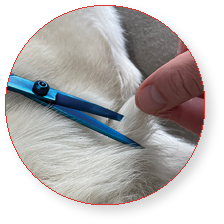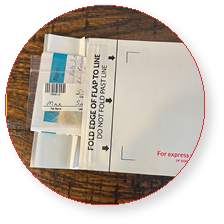Mineral & Toxic Metal Fur Analysis
Mineral and Toxic Metal
Fur Analysis
[ORDER A TEST]
Hair Tissue Mineral Analysis (HTMA)
Fur (hair) is the only matrix suitable for studying a long period of exposure to pollutants or dietary deficiencies for macro and microminerals. Pollutants circulating in the blood, through ingestion or inhalation, are automatically captured by the weft of the fur when it grows and stays intact. By analyzing fur, we can assess any prolonged exposures to potentially harmful minerals and metals, as well as identify any shortcomings the pet’s diet may have.
HTMA is most often indicative of slow, long-term (progressive) problems not acute or transient issues. For this reason, abnormal results aren’t typically viewed at critical emergencies, however further investigation, bloodwork, or diagnostics may be suggested. Learn more about the Mineral and Toxic Metal Fur Analysis by scrolling down.
29 Elements Tested
- 15 Nutritional Minerals
- 10 Environmental Minerals
- 4 Toxic Metals
Test & Treat
- Mineral supplement recommendations for nutritional deficiencies
- Detoxification protocol when toxic metals are present
Which pets should test?
- ADR pets with undiagnosed signs
- As part of general wellness screening
- Pets living in industrial/manufacturing area
- Pets living around commercial farming
- Pets exposed to chemically treated areas (lawns, landscaping, public areas)
- Pets that eat inorganic objects (toys, remotes, items with batteries, food packaging, etc)
- Pets on a high-fish diet
What’s Needed?
- A small, clean fur sample
- No blood, no stool, no liquids
Reports Include:
- 29 Mineral & Metal values
- Description of elements outside of reference range
- Trending data if repeat testing is done
- Detoxification protocol (if warranted)
- Mineral Supplementation Guidelines (if warranted)
- Recommended products for both detox and supplementation
[ORDER NOW]
Gold-Standard Element Testing
Fur analyzed by Triple Quadrupole Inductively Coupled Plasma Mass Spectrometry (ICP-MS). ICP-MS is the gold standard to measure elements at trace levels in biological fluids because of its high sensitivity, its high degree of selectivity, and its good precision for determining many elements in the periodic table. ICP-MS is far superior to Flame Atomic Absorption Spectrophotometry (FAAS) and is the method of choice to measure nutritional and toxic elements.
| Name | Symbol | Description |
|---|---|---|
| Calcium | Ca | Calcium is nutritionally derived often from enriched products such as canned and bagged pet food or dairy items. Calcium is an essential nutrient. |
| Cobalt | Co | Cobalt is a dietary mineral which is essential for cell reproduction, growth, and vital organs. Lack of cobalamin can lead to GI and even neurological issues. Good dietary sources of cobalt include organ meats, beef, and eggs. |
| Chromium | Cr | Chromium is an essential dietary mineral. It can be found from the consumption of products such as yeast, wheat, apples and green pepper. A deficiency of chromium can cause insulin resistance and diabetes. |
| Copper | Cu | Excess copper in fur suggests environmental exposure or consumption of items such as pennies, copper wiring, jewelry or other copper containing metals. Excessive amounts of copper over time may become toxic. |
| Iron | Fe | Iron in fur suggest the digestion of iron rich foods or consuming certain items such as prenatal vitamins, fertilizer, oxygen absorbers and handwarmers. Iron deficiency may be an indication of nutrient deficiencies or underlying conditions. |
| Potassium | K | Potassium is an essential mineral derived from diet. Most pet food and supplements contain potassium iodine, while other potassium-packed foods include salmon, avocado, bananas, sweet potatoes and spinach. |
| Magnesium | Mg | Magnesium is an essential mineral derived from diet. It can be found in whole grains, soybeans, nuts, spinach and fish. Magnesium deficiency is easy to correct and should be evaluated periodically, both in blood and in fur. |
| Manganese | Mn | Manganese is dietary derived and can be absorbed by digesting items that have high concentration of manganese. Whole grains, eggs, nuts and leafy vegetables contain a good amount of manganese. |
| Sodium | Na | Sodium in fur reflects dietary consumption of items that contain high levels of salt such as meat, poultry, fish, ocean water and table salt. |
| Phosphorus | P | Phosphorus in fur reflects environmental exposure and nutritional consumption. Items such as baking powder, fertilizer, and protein-rich foods contain phosphorus. Phosphorus can be toxic if digested in large amounts. |
| Selenium | Se | Zinc is an essential nutrient, often from plant products, however excessive zinc found in fur is due to the consumption of items such bolts, pennies, jewelry, nasal sprays, and many other household items that contain zinc. |
| Silicon | Si | Silicon is a micromineral that is found in small quantities in food. Sources included whole grains, nuts, beans, rice and other plants. Excess silicon in fur may reflects environmental exposure such as in electrical products. |
| Strontium | Sr | Early studies have shown that dogs who eat high levels of sardines or sardine oil supplements have high levels of strontium. Strontium acts in the same way that calcium does in the body and deposits within the bone. |
| Vanadium | V | Vanadium is involved in cellular metabolism and deficiencies should be avoided. Sources of vanadium include: Beans, corn, mushrooms, vegetable oils, root vegetables, shellfish and whole grains. |
| Zinc | Zn | Zinc found in fur is due to the consumption of items such as nuts, bolts, pennies, jewelry, nasal sprays, and many other household items that contain zinc. Ingesting too much zinc can have high toxicity. |
| Name | Symbol | Description |
|---|---|---|
| Silver | Ag | Silver in fur reflects environmental exposure or consumption of certain items such as jewelry, contaminated seafood, metals/chemicals containing silver. |
| Aluminum | Al | Aluminum in fur comes from environmental exposure or consumption of canned foods, vaccines. Processed cheese, dairy products, or aluminum cookware or foil. |
| Gold | Au | Gold in fur is generally due to consumption of item such as jewelry. Gold is chemically inert and will not break down during digestion. Gold will generally pass through the GI tract, assuming it isn’t bulky and causes blockage. |
| Boron | B | Boron exposure is typically environmental through fruit, vegetables, water, air and consumer products (fertilizer), typically in industrial areas, or areas with significant use of pesticides, chemicals, or pharmaceuticals. |
| Barium | Ba | Barium in fur is typically from exposure or ingestion of plants exposed to Barium. Barium is also commonly used as a contrast agent to allow vets to get a good look at the gastrointestinal tract, as it appears bright white on radiographs. |
| Beryllium | Be | Beryllium induced lung disease, also known as berylliosis, has been shown in dogs after being exposed to Beryllium Oxide, usually through burning fossil fuels. Ulcers have also been seen in dogs that ingest Beryllium in their diet. |
| Lithium | Li | Lithium in fur reflects environmental exposure or consumption of lithium rich brines and minerals, or consumption of household items containing lithium batteries such as remote controls, watches, and toys. |
| Molybdenum | Mo | Molybdenum found in fur can be from environmental exposure. Sources include combusted fossil fuels, or consumption of water or food that is exposed to small amounts of molybdenum. |
| Nickel | Ni | Nickel can be introduced to your pets environment or diet from sources which include dog collars, water bowls, food cans, metal walkways, and fences. Foods that are high in nickel include shellfish, chickpeas, and oatmeal. |
| Tin | Sn | Tin in fur is usually from digesting items that contain tin such as cans, foil, cupcake wrappers, etc. Tin is relatively low in toxicity. |
| Name | Symbol | Description |
|---|---|---|
| Arsenic | As | The biggest source of arsenic found in pets is through rice, or contaminated drinking water. Exposure to high levels of inorganic arsenic can cause irritation to stomach and intestines, decreased production of red and white blood cells, as well as lung irritation. Studies show that significant amounts of inorganic arsenic may intensify the chances of cancer development. |
| Cadmium | Cd | Uptake of cadmium mainly occurs through food. Food that is rich in cadmium greatly increase the cadmium concentration in the body. These foods include liver, mushrooms, shellfish, mussels, and dried seaweed. Dogs who are subjected to second-hand smoke have also been found to have high cadmium levels. |
| Mercury | Hg | Mercury enters the environment as a result of normal breakdown of minerals in rocks and soil through exposure to wind and water. Mercury source risks for dogs include fish-based diets, omega oils made with fish, vaccinations, some prescription medications, and environmental contamination. |
| Lead | Pb | Lead is usually introduced into the dog through soil contamination, toys, paint, gasoline exhaust, food packaging, and glazing on ceramic food and water dishes. |
Mineral Deficiencies
When nutritional minerals are low, supplementation may be required. Patient-specific dosing & recommended products are included with any lab report when supplementation is warranted. VDI works with reputable partners to provide safe, proven and effective products to correct deficiencies found from poor diets.
- Patient-specific dose
- Recommended product
- Clear guidelines for simple supplementation
Detoxification Protocol
Metal detoxification can be done safely and effectively using a combination of plant-based products. When used in conjunction they can help to remove unwanted toxins from the body and restore the natural ecosystem in the animal. VDI provides two part, patient-specific, detox regimen for any patients having elevated levels of toxic metals.
Step 1: Prime
Utilize a plant-based antioxidant blend to enhance the body’s natural elimination of toxins out of cells while protecting structures that may be vulnerable to the newly released toxins.
Step 2: Clear
Utilize a silica blend product to bind to the newly released metals and aid in the removal and excretion of the toxins through the gut while protecting the kidneys.
Retest
After a full 2-month cycle on the detox protocol, it’s recommended that the pet be retested to ensure the metals have been cleared. If not, then a second round of detox may be warranted, or we consult with our expert partners in metal detoxification to include other products shown to be effective in eliminating toxins.



